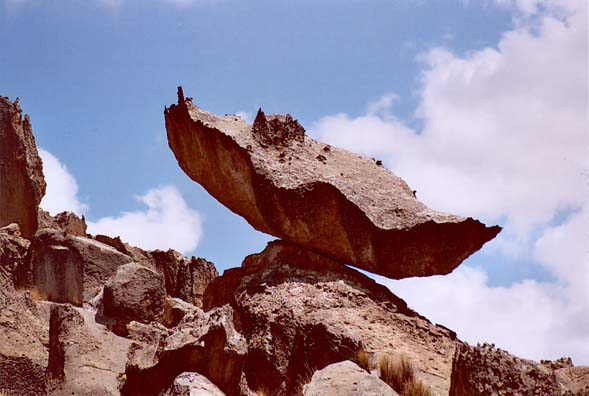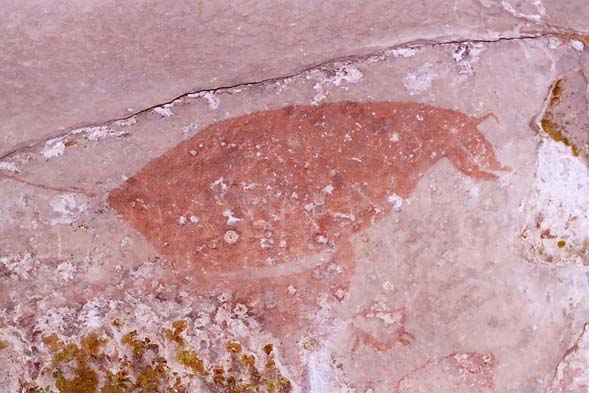
|
This article will appear in South American Explorer, No. XX, YYY 200Z.

|
|
THE ROCK FOREST OF HUAYLLAY
Text and photos by Victor Miguel Ponce |
|
Huayllay, in Pasco, Peru, is the home of the largest and highest geological museum in the world. The site contains an unimaginable collection of rock formations that are both vast and mysterious, while leaving many questions unanswered as to their genesis and meaning. To the unsuspecting visitor, the veritable collection of seemingly precise rock carvings in zoomorphic, anthropomorphic, and a myriad of other shapes invites keen observation and free interpretation, often beyond that which has already been established by local guides. |
|
A marvel far away
Visiting Huayllay is not for the faint of heart. It is a remote area, in a country such as Peru, where attractions such as Cuzco, Machu Picchu and the Nazca Lines overshadow everything else in terms of vacation travel. To visit Huayllay and enjoy its "Bosque de Piedras" [Rock Forest], you must be free-spirited and willing to endure the inconveniences which typically await travelers who stray from the well traveled path. But, alas, once you get to Huayllay, and observe with your own eyes what Mother Nature has been doing for up to 65 million years, you will not be disappointed.
Huayllay is not just a hill with interesting rock carvings. There are plenty of those around. Huayllay is properly a vast and complex array of eroded rocky hills, literally hundreds of them, where time and Mother Nature have joined forces to produce what may well be the largest and highest geological museum the world. The total area of the Huayllay Rock Forest is 6,815 hectares [16,840 acres], lying at an altitude of 4,300 m [14,108 ft], along the High Plains [meseta] of Bombón, in Pasco, central Peru. The climate is cold and steppe-like, with temperatures ranging from 14oC to -8oC [59oF to 18oF]. |

|
| The Elephant. |
|
Geology
The geology of the Huayllay formation dates back to the beginning of the Cenozoic Age, about 65 million years ago. The rocks are of volcanic and sedimentary origin, the latter mostly limestones. What makes Huayllay unique is the prevailing stratigraphy, which has permitted differential erosion to carve some of the most unimaginable figures, literally, rocks of different shapes lying upon rocks, almost as if somebody had painstakingly taken the time to place them one on top of another. A common sight is a rock balancing on one point, with all the remaining degrees of freedom ready to topple it, but for some strange and unexplained reason, it has yet to happen. |

|
| The Bat. |
|
Sculptures
There are eleven routes or paths that can be taken to enjoy Huayllay. Some are easy; others are more difficult and require a time commitment of several hours, and a good guide to be sure. Route No. 1, the closest to the road and, consequently, the most frequently visited, lasts about one hour. Here the visitor can admire the bat, the UFO, the seahorse, the King's crown, the watchman, the thinker, the crocodile, the snail, the fish, and many other seemingly close-to-perfect sculptures.
Other routes feature similar sculptures, with names only limited by the imagination. The more challenging routes require special permits from the local park administration to gain access. All are a marvel for the eye and a haven for the natural-resources photographer, professional or otherwise. Due to the frequent presence of near-vertical walls, taking good pictures requires precise timing and some measure of luck.
|

|
| The Cobra. |
|
Cave paintings
Huayllay features many caves, which contain prehispanic paintings, typically of camelids, but also of other zoomorphic and anthropomorphic drawings. These paintings are positioned in walls, both covered and uncovered, mostly of great size, and painted in several tones of red. The age is attributed to Early preceramic (2500 B.C.-1000 B.C.) to more recent times [For a detailed description of the Huayllay camelid cave paintings, see http://rupestreweb.tripod.com/camelidos.html]. |

|
| Cave painting: The guanaco |
|
How to reach Huayllay. Huayllay is located along the road Lima-La Oroya-Cerro de Pasco. The distance from Lima [measured from km 0 at the outskirts of Lima] to Cerro de Pasco is 285 km [6 hours] along a major paved road. Take this road for about 265 km. Look for a sign that says "Huayllay" and turn left along an unpaved road. From here to Huayllay, the distance is 25 km. Within 2 km, turn left on a T, and sometime later turn left across the bridge over the river. The 12-km stretch closest to Huayllay is paved; there are plans to pave the rest in the near future. The Rock Forest is located near the hamlet of Canchacucho, a short distance before reaching Huayllay, mostly to the right side. Alternatively, take a bus from Lima to Cerro de Pasco, and then hire a taxi or find other means of transportation to reach Huayllay. La Calera Hot Springs, within short reach of the Rock Forest, and open to the public, is another of Huayllay's attractions worth visiting. |

|
| The Nuns. |
|
Victor Miguel Ponce is a regular contributor and advisor to South American Explorer. He teaches civil engineering at San Diego State University and welcomes visitors to his website http://ponce.sdsu.edu |

|
| The Bear. |
| 050908 |